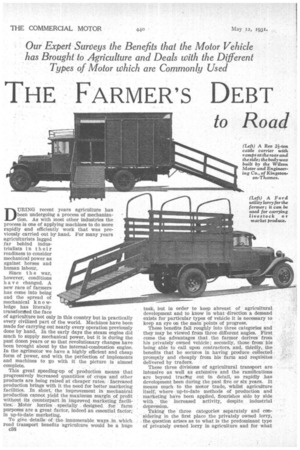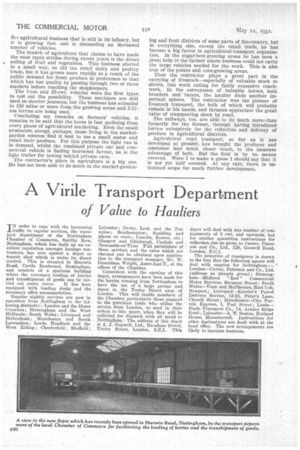THE FARMER'S DEBT
Page 108

Page 109

Page 110

If you've noticed an error in this article please click here to report it so we can fix it.
to Road
Transport
By Our Agricultural Correspondent
DtritING recent years agriculture has been undergoing a process of mechanization. As with most other industries the process is one of applying machines to do more rapidly and efficiently work that was previously carried out by hand. For many years agriculturists lagged far behind industrialists in their readiness to consider mechanical power as against horses and human labour.
Since t h e war, however, conditions have changed. A new race of farmers has come into being and the spread of mechanical k no wledge has literally transfortned the face of agriculture not only in this country but in practically every civilized part of the world. Machines have been made for carrying out nearly every operation previously done by hand. In the early days the steam engine did much to supply mechanical power, but it is during the past dozen years or so that revolutionary changes have been brought about by the internal-combustion engine. In the agrirnotor we have a highly efficient and cheap form of power, and with the perfection of implements and machines to go with it the picture is almost complete.
This great speeding-up of production means that progressively increased quantities of crops and other products are being raised at cheaper rates. Increased production brings with it the need for better marketing facilities. In short, the improvement in mechanical production cannot yield the maximum margin of profit without its counterpart in improved marketing facilities. Motor lorries specially designed for farm purposes are a great factor, indeed an essential factor, in up-to-date marketing.
To give details of the innumerable ways in which road transport benefits agriculture would be a huge c38 task, but in order to keep abreast of agricultural development and to know in what direction a demand exists for particular types of vehicle it is necessary to keep an eye on the main points of progress. These benefits fall roughly into three categories and they may be viewed from three different angles. First come the advantages that the farmer derives from his privately owned vehicle ; secondly, those from his being able to call upon contractors, and, thirdly, the benefits that he secures in having produce collected promptly and cheaply from his farm and requisites delivered by traders.
These three divisions of agricultural transport are intensive as well as extensive and the ramifications are beyond tracPrig out in detail, so rapidly has development been during the past five or six years. It means much to the motor trade, whilst agriculture itself, where up-to-date methods of production and marketing have been applied, flourishes side by side with the increased activity, despite industrial depression. Taking the three categories separately and considering in the first place the privately owned lorry, the question arises as to what is the predominant type of privately owned lorry in agriculture and for what
purpose is it mostly used? To this question no direct answer is forthcoming. It can be said only that there is no predominant type, or, if there should be such at any given moment, changing needs bring in another type and the old one takes a subsidiary position
This constant change, which is characteristic of modern agriculture as contrasted with the agriculture of pre-mechanical-transport days, is a point that motor manufacturers and traders should observe. The main purpose for which the privately owned lorry is used ,• is for conveying produce to market. . As the kind of produce varies with different localities and markets with the kind of produce raised, it 'will be seen that no one type can rule throughout the country.
The model of lorry required by a farmer depends upon the output of his holding, the kind of produce and whether the market be wholesale or retail, as well as upon whether the produce be live or dead. Speaking generally, farmers market their produce both wholesale and retail. Big-scale farmers market their produce whbIesale, whilst those working in a small way usually iretail it: Important commodities dealt with by road transport include milk, potatoes, corn, sugar-beet, fruit, marketgarden produce and livestock. In the eastern counties, Scotland and other parts, potatoes are sent to the wholesale markets by large motor or steam lorries, whilst milk is dealt with .wholesale by large lorries and glass-lined tank wagons which are specially designed for the purpose.
A branch of agriculture calling for variety in body design is livestock carrying. Among the most popular types for this purpose is the 30-40-cwt. vehicle with a body that can be used for carrying a beast or two economically and smaller animals, such as sheep and pigs. Stock raisers frequently use 3-ton and 4-ton chassis with bull boxes or double and treble-deck bodies. The extensive use of large vehicles in the fruit and vegetable trade is well known. In regard to the subject of the farmer's own vehicle, we have also to touch upon the retail side of direct agricultural trading. It was in connection with the retailing of produce that the value of the motor was first recognized, many farmers being able to establish the difference between profit and loss by retailing their own produce Quite early the light van made its appearance in milk retailing,' but somehow it did not "take on" seriously until it came to be understood that there, was a demand for fresh dairy and poultry produce of all kinds, in addition to milk.
The 10-cwt. and 15-cwt. vans were most popular for some time, but as each retailer built up his business a tomer became necessary, and now this and the 25-cwt. and 30cwt. types generally rule. This is a side of the agricultural business that is still in its infancy, but it is growing fast and is demanding an increased number of vehicles.
The branch of agriculture that claims to have made the most rapid strides during recent years is the direct • selling of fruit and vegetables. This business started in a small way, as did the retail dairy and poultry trade, but it has grown more rapidly as a result of the public demand for fresh produce in preference to that which has lost quality by passing through two or three markets before reaching the shopkeepers.
The 1-ton and 25-cwt. vehicles were the first types to test out the possibility. These machines are still used on shorter journeys, but the business has extended to 150 miles or more from the growing areas and 2-21ton lorries are being used.
Concluding my remarks on farmers' vehicles, it remains to be said that the horse is fast declining from every phase of agricultural marketing. Even the small producers, except, perhaps, those living in the marketgarden centres, find it best to use a small motor and retail their produce. For this purpose the light van is in demand, whilst the combined private ear and commercial vehicle is finding increased favour, as is the light trailer for towing behind private cars.
The contractor's place in agriculture is a big one. He has not been able to do much in the market-garden
lag and fruit districts of some parts of thecountry, but in everything else, except the retail trade, he has become a big factor in agricultural-transport organization. In the sugar-beet-growing areas he has been a great. help to the farmer whose business could not carry the large vehicles needed for the work. This.is also true of the potato and corn-growing areas.
Then the contractor plays a great part in the carrying of livestock—especially of valuable stock to shows, this work calling for fairly expensive coachwork. In the conveyance of valuable horses, both breeders and racers, the haulier finds another important sphere. The contractor was the pioneer of livestock transport, the bulk of which will probably reMain in his hands, and farmers appreciate the great value of trausporting stock by road.
The railways, too, are able to do much morei.than formerly for the farmer, through having introduced lorries extensively for the collection and delivery of produce in agricultural districts.
Agricultural„ road transport, so far as it has developed at present; has brought the producer and consumer into much closer touch, to the immense advantage of both. But the field is by no means covered. Were I to make a guess I should say that it is not yet half covered. At any rate, there is undoubted scope for much further development.




































































































































































































